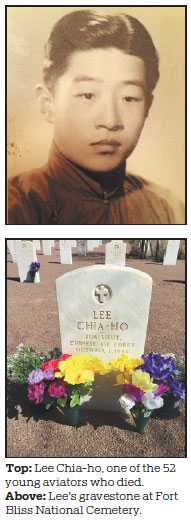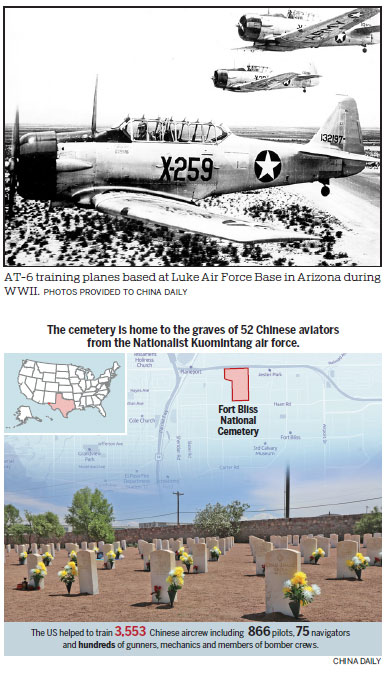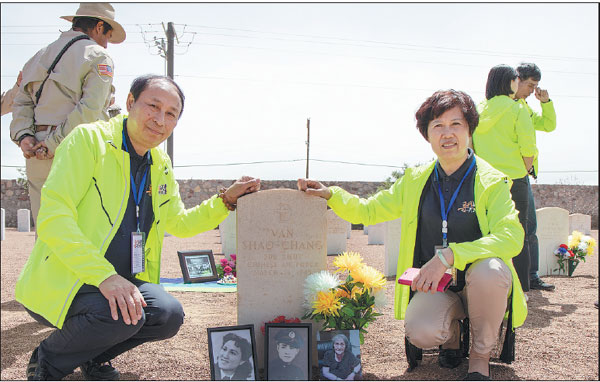Families pay tribute to long-lost Chinese aviators
Relatives travel to the United States to visit the graves of 52 young pilots who died overseas during World War II. Li Lei reports.
On May 13, the United States flag flew at half-mast at Fort Bliss National Cemetery in West Texas as the facility played host to 12 visitors from China and five from the US.
The solemn-looking visitors laid bouquets in front of 52 marble headstones engraved with the words "CHINESE AIR FORCE" that formed a rectangle near the perimeter fence.
Some had brought packs of incense from China, believing they bore the scent of home, while others sprayed Chinese liquor near the graves to show respect and express a sense of loss.
"The day has finally come, Uncle. I am here to see you," said Hu Hanying, who was paying tribute to her relative Lu Ju-hsiang, one of 52 members of the Nationalist Kuomintang air force buried at the cemetery.
The mourners were all descendants of the aviators, mainly young intellectuals from wealthy backgrounds who were recruited from colleges or military academies during World War II and sent to the US for training.
These well-heeled young men volunteered to join the training program, even though they knew the high accident rate meant it would be a dangerous undertaking.
They had hoped to quickly prepare to fight aerial battles at home, where millions of civilians had been killed by the Japanese, who launched air raids and vowed to "burn all, kill all and loot all".
However, none of the young aviators died in battle; instead, they were killed in crashes in the skies above the US between 1942 and 1946, so most of them died as the War of Resistance Against Japanese Aggression (1931-45) in China drew to a close.
The events that followed WWII, including the Chinese Civil War (1946-49) - which resulted in the Kuomintang decamping to Taiwan - and decades of political movements in the Chinese mainland left the country largely isolated.
That meant searching for the aviators' remains was out of the question.
By the time China and the US established full diplomatic relations in 1979, the descendants' memories of their "anti-Japanese heroes" had faded, which hampered efforts to locate the graves.
For more than 70 years, the young aviators lay buried in the cemetery in the Texan desert: there were no visitors, no flowers and no clues as to their whereabouts.
Campaign
The bodies at Fort Bliss have only been identified in the past year or so thanks to the persistent efforts of Ann Lee, whose uncle Lee Chia-ho was one of the aviators, and the Hunan Longyue Center for Peace and Public Welfare Development, which arranged the trip earlier this month.
For almost a year, Ann Lee and the NGO spearheaded a campaign to bring relatives to pay tribute at the graves of the 52 aviators at Fort Bliss, along with five more at Fort Benning Post Cemetery in Georgia.
The campaign began to take shape last year after Lee made her first trip to Fort Bliss to pay tribute to her uncle, who died in 1944 in an air crash that killed eight members of his plane's nine-strong crew.
During the visit, Ann Lee was struck by the tranquil surroundings of her uncle's grave and those of his brothers in arms.
Having spent decades searching, the family's quest finally ended in 2010, when a relative in Taiwan pinpointed Lee Chia-ho's grave at the cemetery.
Ann Lee's visit last year was meant to put an end to the search she had conducted since 2013. Instead, it prompted her to attempt to identify all the Chinese aviators buried alongside her uncle.
To that end, she visited archives in Taiwan and read the memoirs of Kuomintang veterans to pair the Romanized versions of the pilots' names - the order of some family and given names had been reversed - with the Chinese originals.
She enlisted the help of Longyue, which runs a program that helps people find the graves of family members killed in combat, to collect clues to the whereabouts of the dead aviators' relatives. She also attended a hit show broadcast by China Central Television that helps people find missing family members or friends.
To date, she has confirmed the names of 50 of the aviators, 48 places of birth, 34 dates of birth and 40 departure dates. Assisted by Longyue, she has crossed 25 of the 57 aviators' names off her list, and two families are currently awaiting more details.
"They are war heroes," said Ann Lee, now a Chinese-Canadian, who until recently worked in Silicon Valley. "I felt obliged to reunite them with their families, just like my uncle, Lee Chia-ho, and my family."
Tumultuous time
Lee Chia-ho embarked on his journey to the US in autumn 1942, less than a year after the Japanese raid on Pearl Harbor brought the previously neutral country into the war.
The surprise attack led the US to step up its assistance to the Chinese air force in the hope that China could regain control of the skies and become a base for airstrikes on Japan.
The moves included sending the First American Volunteer Group, better known as the Flying Tigers, to China and offering training in the US for hopeful Chinese pilots.
The Nationalist government called on college students nationwide to sign up for the program. Those who passed the entry test were admitted to a flying school in China for preparatory training, before being sent to the US for advanced tuition.
When Lee Chia-ho signed up, he was studying physics at the National Southwestern Associate University, a wartime college in Kunming, capital of the southwestern province of Yunnan.
As the son of a Tsinghua University chemistry professor, he could have continued his studies in Kunming, far from the dangers of war. Instead, he chose to become a pilot, fully aware of the dangerous path on which he had embarked.
At the time, Chinese pilots undertook combat missions after just 20 hours of independent flying. Those who survived for longer than two months were considered extremely lucky. One flying school in Kunming became famous because of a banner hanging on the gate that read: "Those who come for promotion or wealth, please chose other paths. Those who fear death, please do not enter."
Veterans' memoirs show that Lee Chia-ho embarked on his journey along with 56 other young aviators, most of them from wealthy families.
Ann Lee said her uncle's decision to join the war effort was largely due to his upbringing.
Lee Chia-ho was born into a scholarly Beijing family in 1921, two years after the May 4 movement triggered nationwide protests against Western colonialism when the Treaty of Versailles after World War I allowed Japan to keep territories it controlled in East China.
A decade later, Japan staged a false flag operation in Northeast China as a pretext for a full invasion. Lee Chia-ho's mother was among the millions who fled the area.
In 1937, the 16-year-old Lee Chia-ho and his family fled their home in Beijing after the Japanese marched south, aiming to colonize China in just a few months.
Death notice
In 1944, Lee Chia-ho's parents received a notice from the military that broke the news of their son's death.
The document said Lee had died in an accident, but provided no details of the crash or his burial site.
Many years later, Ann Lee wrote to US Aviation Archaeological Investigation and Research, an NGO that helps people obtain military accident reports from the government, to learn the details.

The official report said Lee Chia-ho died in a midair accident, blaming pilot error and bad weather.
Lee Chia-ho was one of many aviators killed in training accidents. According to Craig Fuller, the AAIR's owner and head researcher, about 15,000 aviators have died during training drills overseen by the US Air Force.
Statistics provided by Thunderbird Field, a military airfield in Glendale, Arizona, which was a training base for Allied pilots during WWII, show that the US helped to train 3,553 Chinese aviators during the conflict, including 866 pilots, 75 navigators and hundreds of gunners, mechanics and bomber crew members.
Chai Yong-hua, chairman of Taiwan's China Flying Tiger Research Institute and an expert on air force cooperation during WWII, said Chinese pilots worked closely with their US counterparts in the Pacific, helping the Chinese air force to deliver a heavy blow to the Japanese.
"At the time, the Chinese air force appeared insignificant when compared with those of the major global powers," he said.
He described the young pilots as "patriotic, courageous and ambitious", and said those who didn't return to their homeland should be remembered for the sacrifices they made.
"As members of the elite, they could have led well-off, risk-free lives," he said. "But they chose otherwise, for China's freedom."
Ann Lee, who has vowed to continue searching until the last name is crossed off her list, said her quest is still significant more than seven decades after the war ended.
"The young men buried at Fort Bliss are a constant reminder that history should not be forgotten - peace comes at a price," she said.
"The trivial contribution I can make now is to help reconnect them with their families, and let the younger generation understand the path they chose."
Contact the writer at lilei@chinadaily.com.cn
|
On May 13, Feng Zhong and his wife Lu Fengju pay homage to Feng's uncle Van Shuo-chang, a Kuomintang pilot who died while training in the United States during World War II. Van was buried at Fort Bliss National Cemetery in Texas 74 years ago.May Zhou / China Daily |

(China Daily Global 05/22/2019 page5)



















